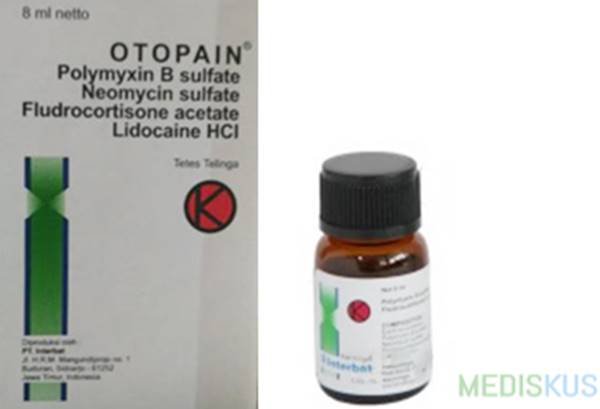
Otopain Uses, Dosage, Side Effects By dr. Aironi IrsyahmaReview medical by dr. Ahmad Muhlisin Otopain is an ear drops that effectively overcome ear infections with some symptoms such as pain, swelling, itching and watery ears. It is a combination drug consisting of antibiotics, analgesics, and anti-inflammatory. Antibiotics on Otopain include polymyxin B sulphate and neomycin sulphate having broad spectrum. While anti-inflammatory drugs such as Fludrokortison Acetate which has anti-inflammatory, anti allergic, as well as anti-itch. Furthermore, for pain reliever (analgetic) in the form of Lidocain HCl which is a local anesthetic agent to reduce the pain in the ear. Getting to Know the Otopain Drugs Ear Ears otopain ear drops are packaged in a small bottle netto 8 ml equipped with ear dropper. Here's the composition for every 1 ml: Polymyxin B Sulphate 10,000 IU Neomycin Sulfate 5 mg Fludrocortisone Acetate 1 mg Lidocain HCl 40 mg. Polymyxin B Sulphate is a mixture of Polymyxin B1 and B2 obtained from Bacillus polymyxa strain. Both are basic polypeptides for about eight amino acids. Polymyxin has cationic action on the cell membrane, causing damage to the bacterial cell membrane. Neomycin Sulfate is an antibiotic that belongs to the aminoglycoside group. Neomycin works by binding to the bacterial 30S ribosomal subunit. This leads to errors in t-RNA readings, resulting in bacteria not being able to synthesize proteins that are important for their growth. Polymyxin and Neomycin Sulfate is a broad-spectrum antibiotic. Both are considered active against Pseudomonas aeruginosa, Staphylococcus aureus, Escherichia coli, Klebsiella, Enterobacter sp., And Neisseria sp. Fludrokortison Acetate is a synthetic adrenocortical steroid that has mineralocorticoid properties and glucocorticoid activity. The physiological work of Fludrocortisone Acetate acetate is similar to hydrocortisone acting as an anti-inflammatory. Lidocain Hydrochloride is an anesthetic agent whose use is indicated as local anesthesia or regional anesthesia. Lidocaine has stronger work and longer effects than Procain but shorter duration of action than bupivacaine or prilocain. Provision of anesthetic agents can effectively reduce the pain caused by ear infections. Indications or Usefulness What drug otopain? In accordance with their respective constituents and mechanisms, otopain may be used to treat outer ear infections (acute and chronic otitis externa) caused by bacteria sensitive to Polymyxin and Neomycin Sulfate. In addition to overcoming the infection by killing bacteria cause, this drug also helps overcome the pain and inflammation that occurred. Contraindications Otopain can not be used in any of the following conditions: Patients known to be hypersensitized to Otopaine or its medicinal components Patients known to be hypersensitized to drugs that have chemical structures resembling Otopain Patients who have acute otitis externally suspected or known to be caused by viral infections, such as Herpes simplex or Varicella-zoster Dose Otopaine and How to Use Follow the doctor's instructions for appropriate dosage and how to use. Adapaun dose prevalent otopain recommended is: Dripped on the sick ear as much as 4-5 drops. The droplet frequency can be given 2-4 times a day, depending on the severity of the disease. The duration of treatment is no more than 10 days, so contact your doctor if there is no improvement during this period. Side Effects of Otopaine Otopain may cause skin sensitization side effects such as: burning itching irritation of dry skin folliculitis (hyperpigmentation-like bruises) hypertrichosis (growing hairs) hyperpigmentation (discoloration darker) contact dermatitis skin allergic and atrophic infections secondary (especially when used for a long time) striae and miliaria. (!) The use of Oropaine ear drops is also reported to be associated with the effects of ototoxicity and nephrotoxicity, consult a physician further. Safety Information Otopain should be given special attention and caution in the following circumstances Neomycin Sulfate may cause sensitization or skin irritation. The otopain ear drops are not recommended for use for more than 10 days because of the greater risk of muscle oxidicity with long-term use. Patients treated with ear drops containing Neomycin should be in close clinical surveillance. Drugs are not recommended for use by patients with perforated tympanic membranes, because their acidity can cause burning and stinging. If the infection does not improve after 1 week, bacterial culture and sensitization testing should be performed to verify the identity of the organism and to determine whether the therapy should be changed. There is no padequate and well-controlled enemas in pregnant women. So this drug is used during pregnancy only if the potential benefit is more than the potential risk to the fetus. Otopain contains sulfites that can cause allergic reactions including anaphylactic symptoms and severe asthma episodes in certain susceptible individuals. The prolonged use of antibiotic ear drops can cause excessive growth of non-sensitive organisms, such as.
Thanks for the time and thanks for reading..
See you again in the following posts follow me steady ya friend-park
Do not forget my Follow & Upvote friends
@steemitcomunity
Thanks you all....